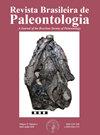伊朗西部高扎格罗斯地区Dashte Zari地区古近系有孔虫组合的生物地层学及古环境意义
IF 0.6
4区 地球科学
Q4 PALEONTOLOGY
引用次数: 0
摘要
古近系Pabdeh组和Jahrum组碳酸盐岩沉积广泛分布于伊朗高扎格罗斯山脉Shahrekord地区西北部(Dashte Zari地区)至西南部,记录了开阔海相向浅水环境的侧向向上过渡。Pabdeh组发育开阔的海相远洋和半远洋灰岩、泥质灰岩和泥质燧石。由浮游微晶岩、颗粒-浮游微晶岩、含浮游有孔虫泥岩和放射虫硅质微晶岩组成,形成于扎格罗斯前陆盆地内。浮游有孔虫分布于晚古新世-晚始新世,对应于亚热带和热带P4b-E15区。Jahrum组以含生物碎屑的灰岩和钙屑岩为代表。由底栖有孔虫碎屑岩、底栖有孔虫-红藻碎屑岩和沉积于浅层台地环境的生物碎屑-碎屑岩组成。Jahrum组在Pabdeh组上部呈交错状,最终在巴统—普里亚盆期整合覆于Pabdeh组之上。浅层和离层关系反映了盆地的收缩,而反复的指间活动则标志着中度的构造沉降。两个地层均被晚渐新世-中新世阿斯马里组不整合覆盖。关键词:生物地层学,Pabdeh组,扎格罗斯,古近系,伊朗本文章由计算机程序翻译,如有差异,请以英文原文为准。
Biostratigraphy and paleoenvironmental significance of Paleogene foraminiferal assemblages from Dashte Zari area in High Zagros, West Iran
The Paleogene carbonate deposits of Pabdeh and Jahrum formations are widespread from the northwest (Dashte Zari area) to the southwest of the Shahrekord region in the High Zagros Mountains of Iran and record the lateral and upward transition from open marine into the shallow water environment. The Pabdeh Formation shows a succession of open marine pelagic and hemipelagic limestone, argillaceous limestone, and argillaceous chert. It consists of planktonic wackestone, pellet-planktonic wackestone, mudstone with planktonic foraminifera, and radiolarian siliceous wackestone, which accumulated within the Zagros Foreland Basin. The planktonic foraminifers are assigned to the Late Paleocene–Late Eocene and correspond to subtropical and tropical Zones P4b–E15. The Jahrum Formation is represented by bioclast-bearing limestone and calcarenite. It consists of benthic foraminiferal wackestone, benthic foraminiferal-red algal packstone, and bioclast-intraclast packstone deposited in a shallow platform environment. The Jahrum Formation is inter-fingered in the upper part of the Pabdeh Formation and finally overlies it conformably during the Bartonian–Priabonian. Shallowing and off-lap relationships record basin shrinking, while repeated inter-fingering signals moderate tectonic subsidence. Both formations are disconformably covered by the Late Oligocene–Miocene Asmari Formation. Keywords: biostratigraphy, Pabdeh Formation, Zagros, Paleogene, Iran.
求助全文
通过发布文献求助,成功后即可免费获取论文全文。
去求助
来源期刊

Revista Brasileira De Paleontologia
PALEONTOLOGY-
CiteScore
1.60
自引率
14.30%
发文量
25
审稿时长
>12 weeks
期刊介绍:
It publishes original contributions on all aspects of Paleontology. Papers are written in English, Spanish, or Portuguese and are reviewed by international experts.
 求助内容:
求助内容: 应助结果提醒方式:
应助结果提醒方式:


